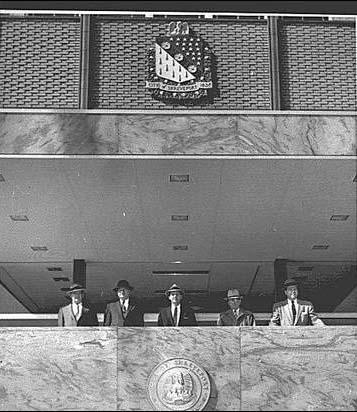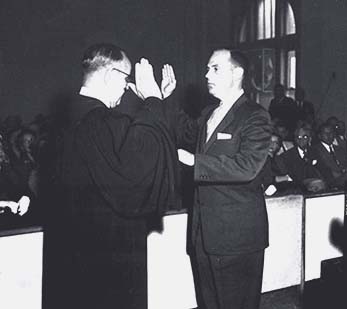

The $19 million solution Bond election sets up 1950's Shreveport for growth
By Mary Jimenez
The Times
March 6, 2005
The 1954-58 Shreveport City Council consisted of members L.E. Phelps (left), commissioner of public utilities; H. Lane Mitchell, commissioner of public works; Mayor Jim Gardner; John McW. Ford, commissioner of finance; and J. Earl Downs, commissioner of public safety.
(LSUS Archives) By Mary Jimenez
The Times
It was the year the Brooklyn Dodgers won the World Series, Elvis Presley sang at the Louisiana Hayride, television came to Shreveport and Rosa Parks refused to change seats on a bus in Montgomery, Ala.
For a 30-year-old mayor, Shreveport and the nation, 1955 was a period full of changes and growth.
March 8 is the 50th anniversary of Mayor Jim Gardner's $19 million City Improvement Bond, the city's largest bond in history, double the previous bond passed eight years earlier. It was passed with great approval only four months after he was sworn into office. Inflated to today's standards the same bond would equal approximately $124,248,313.11.
Gardner was young, but the acceptance of young ideas was a sign of the times.
"WWII was the last war in which everyone was demobilized at the same time," said Gardner, 80, who lives in Shreveport. "Thirteen million young soldiers were discharged and we all came back together unified. We wanted to make home a better place to live. It was a great time of activity for young people."

Mayor Gardner being sworn in as Shreveport Mayor in 1954 by Louisiana Supreme Court Justice, Joe B. Hamiter.
Gardner's love of the city and politics and an amazing memory were invaluable in the years leading up to his election as mayor.
"I had prepared myself to know everything about the city when I came back from WWII," said the native Shreveporter, who served in the Army from 1943-46. "I read all the legal notices and council meetings and remembered everything I read. I had already studied the needs in that bond issue before I was mayor."
The problems facing the new mayor were largely attributed to a booming population growth. From 1927 to 1955, Shreveport's population grew from approximately 65,000 to 150,000 with only one major capital improvement program during that time. The rapid growth caused water restrictions in the summer, backed-up sewers and congested intersections.
The bond issue was broken into four big propositions and five smaller. The first four on the ballot proposed $8 million to create an adequate water and sewage system, $5.6 million for streets, $1.7 million for drainage and $2.5 million to build a civic center on Texas Avenue. The remaining five issues tagged $300,000 for parks and recreation, $100,000 to air-condition the Shreve Memorial Library, $200,000 for street lights, $350,000 for air conditioning and renovation of the Municipal Auditorium and $250,000 to the Department of Public Safety for additional fire stations and modernizing equipment for both the fire and police departments.
Prior to serving as mayor from 1954-58, Gardner served as state representative from 1952-54. Gardner would later serve as president of the Chamber of Commerce and chairman on the first City Council in 1978. He still contributes to the chamber, is on several committees and still attends meetings.
"I'm still interested," he says.
Friend and former Mayor John B. Hussey served with Gardner on the 1978 City Council.
"He was a mentor to me and others. He'd come up with great ideas, then give the ideas to us to bring up," Hussey said. "So in a sense we were taking credit for his ideas."
Not only a student of politics, Gardner had ideas for the city's roads and highways. In 1953 he entered a General Motors contest on "How to plan and pay for the safe and adequate highways we need." He won. The prize, which included $1,500, also came with a trip to a national highway convention. The recognition served him (and Caddo Parish) well with the Louisiana Department of Highways.
So as Gardner's life led him to the mayor's office, he was ready.
One of the most valuable long-term impacts of the bond election was supplementing the city's water supply with Caddo Lake via Twelve Mile Bayou and a 60-inch transmission line. An additional eight miles of 36- and 24-inch mains were laid within the city.
"We haven't had to restrict water since," said Gardner.
The summer before the proposed solution, Cross Lake was very low and the city took a desperate step for help.
"We hired a firm of 'rain-makers,'" Gardner said. "Planes flew over and dropped pellets into the clouds. Whether it helped or not, we don't know, but it did start to rain soon after that."
The major street program initiated by the bond program brought two new four-lane cross-towns. It was only the first steps toward a much bigger vision that would eventually be Interstate 20, Clyde Fant Parkway, the inner loop, Bert Kouns and Interstate 49.
Gardner may like to stay under the radar, but he's honest about his contributions to the city.
"It was historic," said Gardner of the 1955 bond election. "It made changes that would last."
Gardner believes a few leadership qualities helped him along the way: knowledge, tact and love and commitment.
He won't get an argument from anyone who knows him.
Footnote: Former Mayor Jim Gardner is currently working on his second book of memoirs. His first, Jim Gardner and Shreveport which covers his childhood through his term as mayor, was published in 2004 and can be ordered through Ritz Publications, P.O. Box 29182, Shreveport, LA 71149.
Visit www.ritzpublications.com or call (318) 996-0419.





© Ritz Publications 2003-2006